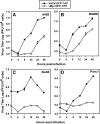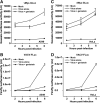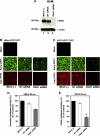Myxoma and vaccinia viruses exploit different mechanisms to enter and infect human cancer cells
- PMID: 20334889
- PMCID: PMC2862966
- DOI: 10.1016/j.virol.2010.02.027
Myxoma and vaccinia viruses exploit different mechanisms to enter and infect human cancer cells
Abstract
Myxoma (MYXV) and vaccinia (VACV) viruses have recently emerged as potential oncolytic agents that can infect and kill different human cancer cells. Although both are structurally similar, it is unknown whether the pathway(s) used by these poxviruses to enter and cause oncolysis in cancer cells are mechanistically similar. Here, we compared the entry of MYXV and VACV-WR into various human cancer cells and observed significant differences: 1--low-pH treatment accelerates fusion-mediated entry of VACV but not MYXV, 2--the tyrosine kinase inhibitor genistein inhibits entry of VACV, but not MYXV, 3--knockdown of PAK1 revealed that it is required for a late stage event downstream of MYXV entry into cancer cells, whereas PAK1 is required for VACV entry into the same target cells. These results suggest that VACV and MYXV exploit different mechanisms to enter into human cancer cells, thus providing some rationale for their divergent cancer cell tropisms.
2010 Elsevier Inc. All rights reserved.
Figures








Similar articles
-
Myxoma and vaccinia viruses bind differentially to human leukocytes.J Virol. 2013 Apr;87(8):4445-60. doi: 10.1128/JVI.03488-12. Epub 2013 Feb 6. J Virol. 2013. PMID: 23388707 Free PMC article.
-
RNA Helicase A/DHX9 Forms Unique Cytoplasmic Antiviral Granules That Restrict Oncolytic Myxoma Virus Replication in Human Cancer Cells.J Virol. 2021 Jun 24;95(14):e0015121. doi: 10.1128/JVI.00151-21. Epub 2021 Jun 24. J Virol. 2021. PMID: 33952639 Free PMC article.
-
Myxoma virus oncolytic efficiency can be enhanced through chemical or genetic disruption of the actin cytoskeleton.PLoS One. 2013 Dec 31;8(12):e84134. doi: 10.1371/journal.pone.0084134. eCollection 2013. PLoS One. 2013. PMID: 24391902 Free PMC article.
-
Replicating poxviruses for human cancer therapy.J Microbiol. 2015 Apr;53(4):209-18. doi: 10.1007/s12275-015-5041-4. Epub 2015 Apr 8. J Microbiol. 2015. PMID: 25845536 Review.
-
Entry and Disassembly of Large DNA Viruses: Electron Microscopy Leads the Way.J Mol Biol. 2018 Jun 8;430(12):1714-1724. doi: 10.1016/j.jmb.2018.04.019. Epub 2018 Apr 24. J Mol Biol. 2018. PMID: 29702107 Review.
Cited by
-
Modulation of the myxoma virus plaque phenotype by vaccinia virus protein F11.J Virol. 2012 Jul;86(13):7167-79. doi: 10.1128/JVI.06936-11. Epub 2012 Apr 18. J Virol. 2012. PMID: 22514354 Free PMC article.
-
SAMD9 is an innate antiviral host factor with stress response properties that can be antagonized by poxviruses.J Virol. 2015 Feb;89(3):1925-31. doi: 10.1128/JVI.02262-14. Epub 2014 Nov 26. J Virol. 2015. PMID: 25428864 Free PMC article.
-
Orthopoxvirus species and strain differences in cell entry.Virology. 2012 Nov 25;433(2):506-12. doi: 10.1016/j.virol.2012.08.044. Epub 2012 Sep 20. Virology. 2012. PMID: 22999097 Free PMC article.
-
A comparative review of viral entry and attachment during large and giant dsDNA virus infections.Arch Virol. 2017 Dec;162(12):3567-3585. doi: 10.1007/s00705-017-3497-8. Epub 2017 Sep 2. Arch Virol. 2017. PMID: 28866775 Free PMC article. Review.
-
Myxoma virus suppresses proliferation of activated T lymphocytes yet permits oncolytic virus transfer to cancer cells.Blood. 2015 Jun 11;125(24):3778-88. doi: 10.1182/blood-2014-07-587329. Epub 2015 Apr 22. Blood. 2015. PMID: 25904246 Free PMC article.
References
-
- Andres A, Donovan SM, Kuhlenschmidt TB, Kuhlenschmidt MS. Isoflavones at concentrations present in soy infant formula inhibit rotavirus infection in vitro. J Nutr. 2007;137:2068–73. - PubMed
-
- Barrett JW, Alston LR, Wang F, Stanford MM, Gilbert PA, Gao X, Jimenez J, Villeneuve D, Forsyth P, McFadden G. Identification of host range mutants of myxoma virus with altered oncolytic potential in human glioma cells. J. Neurovirol. 2007a;13:549–560. - PubMed
-
- Barrett JW, Sypula J, Wang F, Alston LR, Shao Z, Gao X, Irvine TS, McFadden G. Myxoma virus M063R is a host range gene essential for virus replication in rabbit cells. Virology. 2007b;361:123–132. - PubMed
Publication types
MeSH terms
Substances
Grants and funding
LinkOut - more resources
Full Text Sources
Other Literature Sources
Research Materials

